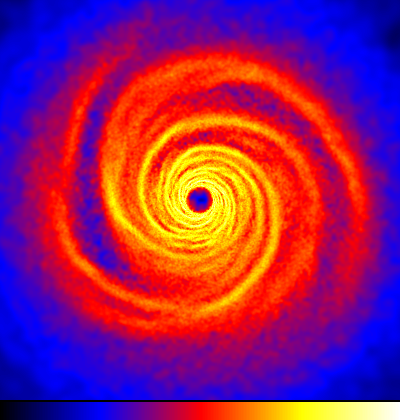Self-gravitating accretion discs
It is fairly well accepted that planet formation takes place in discs around young stars. What is
far less certain (in particular for gaseous planets like Jupiter and Saturn) is the details of the
planet formation process. In my research I use numerical simulations to study the dynamical evolution
of gaseous protoplanetary accretion discs. In particular I am interested in those discs that may be sufficiently
massive for self-gravitaty to play a role in their evolution. The main focus of this work is how
self-gravity may influence planet formation and the transport of angular momentum, a process that is
required in order for the gas in the disc to accrete onto the central star.
Gravitational instabilities
Accretion discs may be susceptible to the growth of a gravitational instability if they
are sufficiently cold, sufficiently massive, or both. If a disc is able to cool, then it may
become sufficiently unstable for the growth of the gravitational instability. In work done
with Phil Armitage, Ian Bonnell, and Matthew Bate, we find that for relatively long cooling times, the instability grows
but the disc ultimately attains a long-lived state of marginal stability
(Left hand figure below). On the other hand, if the cooling time is very short, the disc may become
extremely unstable and may fragment into bound gaseous objects. It is these objects that are
thought to be possible precursors to giant gaseous planets.

|

|
A self-gravitating accretion disc that
has evolved into a quasi-steady state. |
A disc in which bound objects are forming
through disc fragmentation. |
The effect of cooling on the global stability of self-gravitating protoplanetary discs, W.K.M. Rice, P.J. Armitage, M.R. Bate & I.A. Bonnell, MNRAS, 339, 1025 (2003)
Astrometric signatures of self-gravitating accretion
discs, W.K.M. Rice, P.J. Armitage, M.R. Bate, I.A. Bonnell MNRAS, 338, 227 (2003)
The formation of gas giant planets
If the cooling is fast enough, a disc may fragment into numerous gravitationally bound objects. In work
done with Phil Armitage, Ian Bonnell, Matthew Bate, Sandra Jeffers and Steve Vine, we assume that planets
can form through the gravitational instability mechanism and evolve a simulation until all the gas is consumed
and the system (containing a central star and planets) is in a stable configuration. What remains is a single
massive planet orbiting the central star with an eccentricity and semi-major axis that is comparable to
that observed in some extra solar planetary systems.
Substellar companions and isolated planetary mass objects from protostellar disc fragmentation, W.K.M. Rice, P.J. Armitage, I.A. Bonnell, M.R. Bate, S.V. Jeffers & S.G. Vine, MNRAS, 346, L36 (2003)
Accelerated planetesimal growth in self-gravitating discs.
Although it is interesting that disc fragmentation can lead to massive planets with orbital
properties similar to that of some observed extrasolar planets, there are a number of
problems with this scenario: the planets that form are fairly massive (it seems difficult
to form Saturn mass planets for example), and the required cooling time may be unrealistically
short. The alternative, more widely accepted scenario, is that initially a rocky/icy core forms
that then accretes a massive gaseous envelope. This too has a number of problems: the core
must form within approximately 10 million years, and the dust grains that coagulate to form the
planetesimals from which the core is formed may undergo a phase of rapid inward migration. With
Phil Armitage I have been working on a new core accretion model that appears to form gaseous planets
within 10 million years. This, however, still assumes that km sized planetesimals can form through
dust coagulation, and doesn't address the issue of rapid inward migration of cm sized dust grains.
To address this issue I have been working with Guiseppe Lodato, Jim Pringle,
Phil Armitage, and Ian Bonnell on the evolution of dust grains and small
planetesimals in self-gravitating discs. It is quite likely that protoplanetary
discs will at some stage undergo a self-gravitating phase. In a non-self-gravitating disc,
dust grains will tend to migrate inwards due to the influence
of gas drag. The migration rate depends on the grain size and can reach speeds of 1000 cm/s
for cm sized grains. Dust grains of this size could then migrate into the central star within a
few thousand years, creating rather a serious problem for the formation of km sized planetesimals.
In a self-gravitating disc, however, we find that cm sized dust grains concentrate near the
centers of the spiral structures. This concentration of dust grains enhances their density
and collision rate, potentially leading to a significant acceleration in their growth rate
and hence allowing these grains to grow into planetesimals rather than migrating into the
central star.

|
| Surface density structure of the gaseous disc. |

|

|
Surface density structure of 10m
planetesimals. This structure is very
similar to the structure in the
gaseous disc. |
Surface density structure of 50cm
planetesimals. These particles are strongly
concentrated in the center of the
spiral arms. |
Accelerated planetesimal growth in self-gravitating protoplanetary discs, W.K.M. Rice, G. Lodato, J.E. Pringle, P.J. Armitage & I.A. Bonnell, MNRAS, in press
|